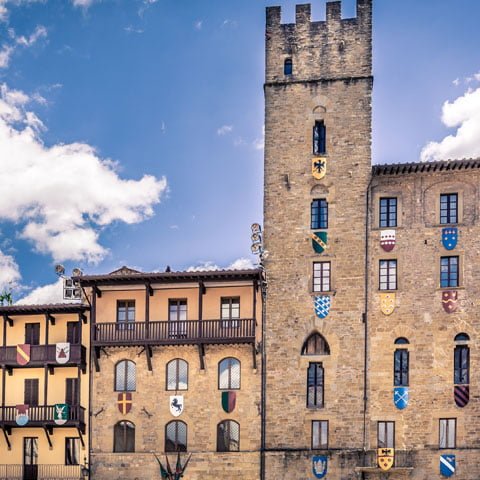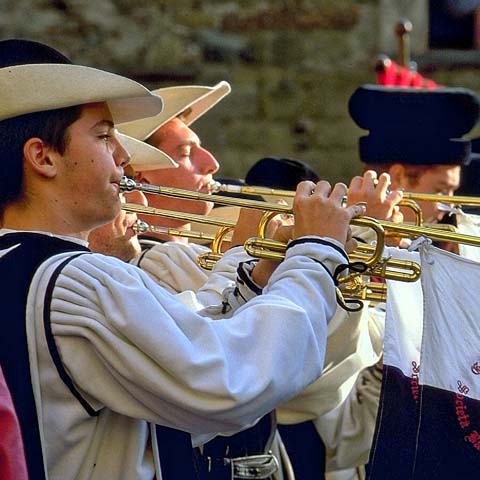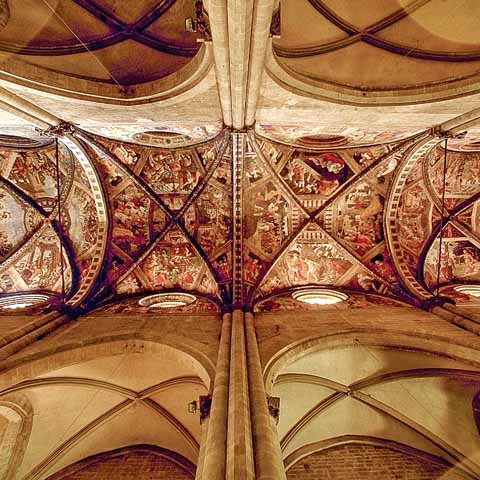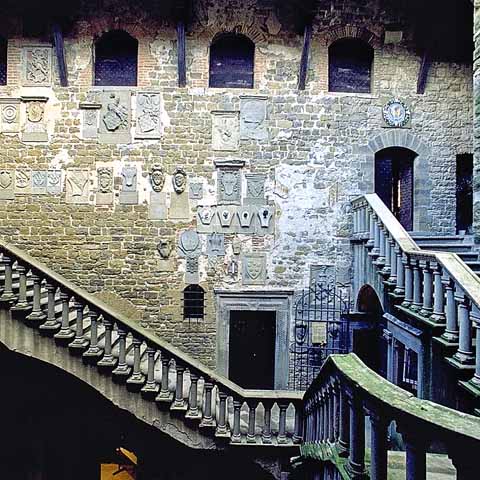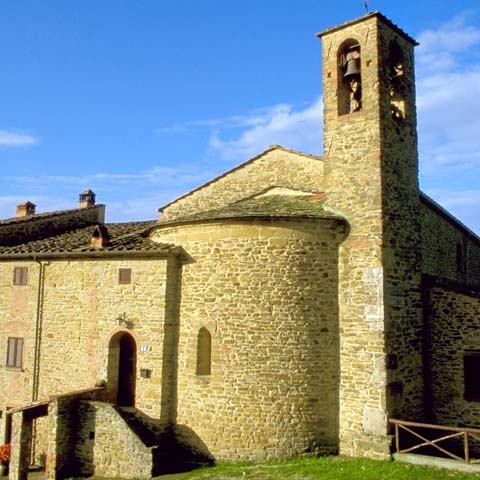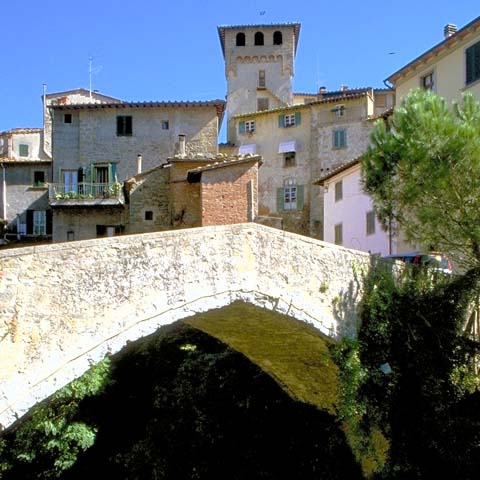The picturesque city of Arezzo is located it the heart of the Tuscany region approximately an hour and half southeast of Florence. Positioned on a hill, the city’s roots can be traced back to the Villanovans and the Etruscans. The historic city center is characterized by medieval architecture and the vast Piazza Grande.
The artistic heritage of the city is impressive as several important artists and poets were born in Arezzo, including Giorgio Vasari and Francesco Petrarca. Additionally, Michelangelo and Piero della Francesca were both born in the province of Arezzo. One of the latter artist’s masterpieces, a cycle of frescoes, can be admired in the Basilica of San Francesco.
Arezzo’s city center served as the filming location for much of the Academy Award-winning film La vita è bella (1997), which was directed by Roberto Benigni, another son of the province of Arezzo. The city is also known for its monthly antique fair, which is one of the most important of its kind in Italy. Today, Italian and international travelers visit Arezzo to admire its beauty and experience Tuscany at a slower pace.
PREHISTORY OF AREZZO
Arezzo is a city of art with an ancient history located in the eastern part of Tuscany, which was once ancient Etruria and known as Tuscia.
According to historians, Arezzo was founded by the Villanovan populations, before it became part of the Etruscan Dodecapolis, which were the 12 most important Etruscan cities. The Etruscans named the settlement Arretium.
In 311 BC, the city suffered the occupation of Rome. During the third century BC, Arezzo, which had become an Etruscan-Roman town, fought alongside Rome against the Gauls and became a strategic point for the expansion of Rome towards the north. During the Roman civil wars, Arezzo became a Roman colony, and the city subsequently grew and flourished.
Under the rule of Emperor Augustus, Arezzo was one of the largest cities in the Italian peninsula. The craftsmanship in the city was highly developed, especially in the manufacture of pottery. Consequently, trade was fervid and pottery was widely exported. The coral vessels produced in Arezzo reached as far as India.
During the Roman period, the city walls were enlarged, and the second century AD amphitheater, theater, and baths were built. Gaius Cilnius Maecenas, who became Minister and Counselor to Emperor Augustus, was an Arezzo native who promoted the development of economics and the arts.
HISTORY OF AREZZO
After the Roman Empire, the Lombards built castles and parish churches. During this period, Arezzo retained its importance.
After the defeat of the Lombards by the Franks, the city became part of the Carolingian Holy Roman Empire.
During the tenth and eleventh centuries, the city was ruled by a Bishop-Count who lived in a castle-fortress and was appointed directly by the Emperor.
Subsequently, Arezzo gained independence and ecclesiastical power was reduced. From 1098 to 1384, Arezzo functioned as an independent city-state.
Around 1200, the city walls were enlarged once more. Additionally, churches, palaces, towers, and the cathedral were built. During this period, the municipality was part of the Ghibelline faction that supported the Emperor. In 1252, the city founded its university.
Arezzo supported the imperial army against the Guelph forces of Florence that were financed by the Pope. The Ghibellines were eventually defeated in Campaldino in 1289, an event that triggered an economic and cultural crisis for Arezzo.
In 1384, the history of Arezzo was incorporated into that of Florence and of the Medicean Grand Duchy of Tuscany. Despite the loss of independence, cultural and artistic liveliness thrived in the city.
Arezzo’s medieval and Renaissance period was marked by artists such as Guittone d’Arezzo, Cimbue, and Piero della Francesca.
During the sixteenth century, Giorgio Vasari, Guglielmo de Marcillat, and Bartolomeo Ammannati embellished the city.
Under the Medici, new walls were built in addition to several noble residences. Eventually, the architectural landscape of the city changed with some medieval buildings giving way to new buildings with a Renaissance imprint.
With the arrival of the seventeenth century, Arezzo suffered, like the rest of the peninsula, decades of epidemics, poverty and decline.
In the eighteenth century, the neighboring marshes of the Val di Chiana, south of Arezzo, were drained. As a result, malaria was less-widespread. At the end of the century, the city was conquered by Napoleone Bonaparte and his troops. From 1799 to 1800, the city turned into a resistance base against the invaders and earned the role of provincial capital.
Garibaldi’s Expedition of the Thousand aroused the enthusiasm of the Arezzo population, which contributed significantly to the success of the Garibaldian enterprise (volunteers were sent and funds were raised for the Sicilian voyage). Following this undertaking, Garibaldi was made an honorary citizen of Arezzo.
In 1861 Arezzo became part of the Unified Kingdom of Italy.
Until the end of World War I, the city’s economy was essentially based on the cultivation of the surrounding countryside
During World War II, Arezzo’s partisans fought against the Germans. In 1944, the German retaliation against the Arezzo partisans and local population increased dramatically. At the same time, bombings by the Allies were becoming more and more numerous with serious consequences: many buildings were destroyed and inhabitants left the city.
After the war, the government worked to rebuild what had been destroyed. Additionally, the industrial vocation of the city grew with the processing of precious metals. During this time, hundreds of small and medium-sized companies that specialized in this activity were founded. This led to a solid local economy and Arezzo become one of Tuscany’s influential cities. Today, the city’s economy is also partly based on tourism.
ARCHAEOLOGY IN AREZZO
Archeology abounds at the Gaius Cilnius Maecenas Museum, which can be found in Arezzo’s Monastery of Monte Oliveto. On the grounds of the museum are the ruins of the city’s Roman amphitheater, which dates back to the first half of the 2nd century AD. This was once the largest public building in the Roman city.
On the ground floor, visitors can admire artifacts from the Etruscan period to late antiquity. In the upper section of the museum, prehistoric ceramics and bronzes are on display. Not to be missed are the jewels from the Poggio del Sole necropolis, votive busts, and Etruscan funerary sculptures.
Other artifacts can be admired at Etruscan sites throughout the province of Arezzo, particularly in the Casentino area, which features an archaeological museum in Bibbiena. Known throughout the Roman Empire for the creation of vases, Arezzo left many traces of this artistic vocation. The Archeological Museum of Casentino in Bibbiena preserves the richest collection in the world of Arezzo sealed terra-cotta vases, formerly called Arretina vasa, which made the city famous in antiquity. Other sections of the museum feature exhibits focusing on paleontology, prehistory, the early Middle Ages, and numismatics. Precious metals, ceramics, and bronzes are on display as well.
Also outside of Arezzo, it is possible to visit the archaeological zone of Castelsecco-San Cornelio. The site features ruins that can be traced back to the first century AD.
Don't just see Italy, live it.
Your dream trip to Italy has never been closer
No more endlessly scrolling travel sites. Our travel experts will craft the perfect, one-of-a-kind trip just for you.

300+
DESTINATIONS
We offer more Italian destinations than any travel site. Do and see more with Trips 2 Italy.
1 (of a kind)
ITINERARIES
Because your dream trip to Italy should be designed for you, not for the masses.
100%
PEACE OF MIND
From flights and accommodations, to food and activities - we take care of every detail.
